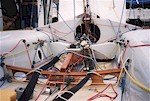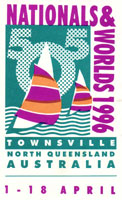 |
505 World
Championship 1996 Photos
taken at the 505 World Championship in Townsville Australia by
Ali Meller. |
|
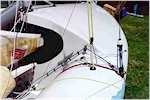 |
Bergstrom's shroud system. Starboard shroud detail on Bergstrom's Rondar.
Note the tensioning tackle is fastened to the rail. The Australian's do
the same, while North American boats tend to have the tackle inside the
boat. This approach reduces the load on the rail of the boat, is easy to
do – especially as a retrofit to an older boat – and is light. |
Putting
the tackle inside the boat gives you a good chance of saving the mast or
mast gate if the system breaks, while with this system, if the line breaks,
either your mast or your mast gate, or both, break. Note the calibration
marks on the bulkhead. There were lots of varations of calibration markings,
including systems that showed what the shroud tension was set to, even
though the tackle itself was hidden. Light lines and shockcord takeups were
rigged to act as shroud tension indicators.
 |
Bergstrom's spinnaker launcher. Many of the Rondar boats have this tube
in the launcher tube. It moves the tack forward and down, and allows the
forestay to be extended back into the boat for adjustment. Note that
Bergstrom appears to have a 2:1 block here. This would reduce the
compression load on the deck as he tightens the forestay. |
 |
Bergstrom's centerboard cap – detail. The Rondar and the Kyrwood have
wider centerboard caps, and frequently control lines are lead such that
you pull it from either side, with a cleat on the centerboard cap. I
believe every control line in Bergstrom's boat is on a shockcord takeup.
Note the absence of a mainsheet jammer; Krister just has a block on the
CB cap. He cannot cleat his mainsheet. Bergstrom's boat is one of the
more complex. He uses the smallest blocks and lines he can. |
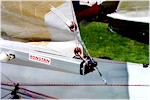 |
Ebbe
Rosen/Olle Wenrup's boat, boom end detail. Both this boat – a Waterat –
and Bergstrom's had flattening reefs rigged. The outhaul appeard fixed
(not adjustable while sailing), and the fittings were used for the
flattening reef instead. The boom is cut to minimum length and uses the
standard end fitting, with a small amount of customization. Note the end
of the spinnaker pole - many 505s use spinnaker pole launchers.
|
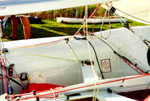 |
Rosen/Wenrup jib sheeting. Rosen/Wenrup lead the jib to an aft turning
block, and then pull the lead out or down/in.
Click here for more photos. |
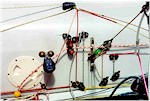 |
Ebbe
Rosen/Olle Wenrup's boat, jib lead and some control systems. I think the
lime striped line coming and going from/to the left (towards the bow) is
the jib sheet. Barber haulers control the jib lead angle. Note all the
adjustments on the tank, the careful leading of lines, and the extensive
use of shockcord takeups. |
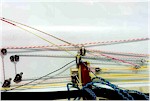 |
Ebbe
Rosen/Olle Wenrup's boat, working aft from the previous image. Moving
aft (to the right) of the previous image, you can see more of the
control systems. The low thwart to the right of the image center, is the
low aft thwart of a Waterat. The solid yellow is all shockcord for
takeups. |
 |
Jib
sheeting detail on 7200. OK! OK! So 7200 (Meller/Mills) were not one of
the better boats at the Worlds! I happen to be very partial to this boat,
and wanted to throw in a picture or two. Don't you think the oak veneer
on the cored tank, and the mahogany elswere is gorgeous? |
USA7200
has the standard Waterat fore-and-aft jib lead tracks that I am very used
to, but also has a barber hauler to pull the lead out. Note that the
barberhauler pulls the lead forward (or down) as it pulls it outboard. A
light shockcord pulls the floating barberhauler block down to a Ronstan
cheek block mounted above the jib cleating platform. This does not alter jib
lead angle, but prevents the barberhauler block from getting tangled on
something, or from scarring the finish on the seat tank.
|
This
is a Rondar 505
This system
is typical of the Australians and many Europeans. Rondar Raceboats have
been building successful 505s for over 25 years and are considered the
predominant builder. |
 |
Their
standard boart is a championship winner and features construction with
SP Systems epoxy resins with tri-axial cloth. Carbon and Kevlar
reinforcement are used extensively in high stress areas and vacuum bag
foam sandwich construction is used in deck and hull mouldings. |
 |
Check out
the trailing edge of the centerboard! The chord is smaller where the CB
emerges from the centerboard trunk underneath the boat, than it is just
a inch or two below that on the blade. I think the idea is that the foil
is not very efficient next to the bottom of the boat, and why have the
drag of a long chord here.... On the other hand it looks neat.
Contact
these guys for ordering! |
This
is a Kyrwood 505
 |
This system is typical of the
Australians and many Europeans. The STANDARD KYRWOOD... is a combination
of hand laid fibreglass reinforced plastic, and end grain balsa core
sandwich construction achieving a stiff, light hull, combining the
performance of sandwich construction with the low maintenance properties
of fibreglass. |
The hull
has balsa extending well around the bilges, forming a channel from bow to
stern reducing hull distortion caused from rig loadings. Extreme panel
stiffness on all planing surfaces eliminates loss of energy and lift due to
hull flex.
The deck is balsa
ribbed and is of a single moulding, incorporating spinnaker shute, jib
furler well, mast thwart and transom, as well as a unique centerboard case
thwart which resists rig compression forces. A separate centerboard case top
moulding combines mast support and compass mounting. Allowance has also been
made for control cleats and sheeting systems.
 |
Left: Kyrwood c/b case, late
80's model. Note the lifting pin system.
|

Deck layout of Project – Australian Champion 1997/98
This is a
Duvoisin 505


505 Sweden Archive Home
—
Sv.505 Förbundet —
Uppdaterad
2021-04-14
|









